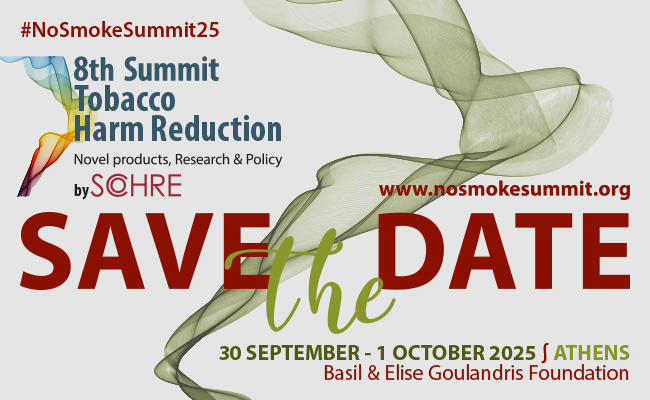The 7th Tobacco Harm Reduction Summit started with an interesting session including a vivid discussion, chaired by Professor Ignatios Ikonomidis, in which world-class experts Louise Ross from UK and Marewa Glover from New Zealand shared with the audience the success stories of their countries that have implemented THR policies for smoking cessation.
In his opening remarks, Professor Ignatios Ikonomidis mentioned that non-communicable diseases (NCDs) account for the vast majority of deaths worldwide. This is driven, he explained, by an epidemic of cardiovascular pathologies, cancer, and lung disease, which share tobacco use as a determining risk factor. Besides the effects on the individual level, this detrimental association resonates also with the community, as it results in a significant socioeconomic burden, particularly in low- and mid-income countries.
Health literacy defines the ability to obtain, interpret, and practically utilize information to make appropriate health decisions, and, according to the World Health Organization, it plays a pivotal role in the prevention and management of NCDs. So, it is our mission to empower the public with high-quality information regarding THR; equally this could form a bridge of communication with public health regulators and policymakers, aiming to overcome the resistance to implementing proven THR practices, in line with the harm reduction principles of the Framework Convention on Tobacco Control (FCTC).
To this end, we will try to implement all methods of smoking cessation, Professor Ikonomidis said. This effort has been introduced in the American Heart Association (AHA) guidelines for the management of patients with chronic coronary disease and, also, in the recently published guidelines of the European Society of Cardiology (ESC) for the management of peripheral arterial and aortic diseases. Of course, electronic cigarettes may be considered as an aid to quit tobacco smoking, but it is advisable to limit their use and avoid simultaneous use with conventional cigarettes due to unknown long-term effects. So, it appears that cardiac societies, in their effort to cease smoking, are using and utilizing new methods to achieve that, in line of course with previously known methods like pharmacotherapy and nicotine replacement treatment, Professor Ikonomidis concluded and presented the first speaker Mrs Louise Ross.
England’s National “Swap to Stop” Programme
Mrs Louise Ross talked about the England’s “Swap to Stop” programme, which was the first of its kind to integrate vaping into a government-funded stop-smoking initiative. By recognizing that vapes are the most effective aid to quitting smoking, the programme provided free vapes to individuals who might never have sought help from a traditional Stop Smoking Service, Mrs Ross explained.
England has a long tradition of helping people to stop smoking, Louise Ross said, since its first stop smoking clinics were set up in 1999. These public services, she continued, follow the NCSCT Standard Treatment Programme, they deliver behavioural support and stop-smoking aids and they focus on the most disadvantaged communities, on people who live in really difficult circumstances. England has organizing also many “Call to Action” campaigns, that aim to persuade people that stopping smoking is the best decision they can make for their health.
“Swap to Stop,” a government-led offer inspired by Dr Javed Khan, who listened when people said that vapes were the most popular and most effective aid to stop smoking, is an unprecedented chance to distribute free vapes to 1 million people who may never have come to a Stop Smoking Service.
The programme is funded by central government and made operational by local government, Louise Ross explained, training is done from the NCSCT, the local Stop Smoking Services provide the local leadership and partners include frontline services who have regular contact with people who smoke, such as housing associations, substance use services, mental health outreach, debt management services, LGBTQ services and any other services where staff regularly talk to people who smoke.
One of the biggest challenges is the incorrect information about vaping, Mrs Ross continued. Some of the most common misconceptions are that when you switch from smoking to vaping you just swap one addiction for another, the threat of a ‘youth epidemic’, as well as the false belief that vape products are unregulated and that they are worse than smoking.
Of course, there are still some practical issues that we must deal with, Mrs Ross concluded, but the initiative is a low-cost opportunity to change the lives of people who smoke.
New Zealand’s SmokeFree Ambition
Dr Marewa Glover presented the progress of Tobacco Control Programme in New Zealand, which led to a substantial decline in smoking of combustible cigarettes, especially after the regulation of vaping by the country’s government in 2019-2020.
Daily smoking and vaping prevalence data show that in New Zealand smoking has declined mainly because of vaping, Dr Glover explained. A decade ago, the percentage of smokers across the whole country was 16.4%, and the reduction of this percentage was frustratingly slow until 2017-18, when we started to see the prevalence of vaping increasing. In 2019, when the previous government regulated vaping, there was a rapid increase in vaping, and in 2022-23 daily vaping was up to 9.7%, Dr Glover noted. The government has launched also a mass campaign, encouraging any adults who smoked, if they could not quit any other way, to switch to vaping, and even the Prime Minister was on TV saying that they also launched a vaping facts website to address the myths and some of the concerns people had about vaping. The success story of New Zealand, Dr Glover mentioned, is not only that in 2022-23 smoking has dropped to 6.8%, but also that smoking prevalence declined both in European and indigenous Maori population.
The rapid decline in smoking in the UK, NZ, Japan, Korea, Iceland and the USA provide proof that THR products are effectively displacing combustible cigarettes, the speaker added. The scientific evidence that THR products are the predominant cause of this decline is becoming stronger.
Countries who have opted for a prohibitionist approach to eliminating all tobacco and nicotine use, are providing clear examples of how prohibition slows the reduction of smoking, and thus cause an unacceptable delay in the reduction of smoking-related deaths. Of course, negative misinformation about the greatly reduced harm of THR products compared to smoking is slowing the mass exodus of people from smoking to THR/quit, Dr Glover concluded. This needs urgent research and policy attention if the smoking death toll of 7-8 million a year is to be reduced as fast as is now possible.
Discussion
Professor Ikonomidis thanked both speakers for their presentations and asked Mrs Ross about the flavours that are allowed to the “Swap to Stop” programme in UK.
Different flavours are allowed, Louise Ross said. Tobacco is one of the least popular flavours, but the fruit flavour is also very popular. Flavours should not be banned, since many people say that they keep them from going back to smoking. If flavours help people stop smoking, which is uniquely harmful, then they are doing a good public health job.
To a question whether the new government in UK is going to continue the “Swap to Stop” programme, Louise Ross replied that it’s being discussed just at the moment and there will be the budget announcement at the end of October. So, until then, there is uncertainty. She added that the programme continues until the end of March and that their priority is to make sure that they make the most of what is available right now, keeping their fingers crossed that it will be continued.
A series of questions from the audience led to a discussion on policies on vaping and market regulation in the UK and NZ. Professor Ikonomidis asked Dr Glover which legislative changes she believes New Zealand’s government should make.
It’s important to regulate, obviously, Marewa Glover answered, and she added: “I think probably what is missing in New Zealand and in many other countries is the enforcement. We do have a nicotine limit, but not as low as the EU. We need to assess the scientific evidence, to make sure that the products that are available are effective for people to switch to, that they will enable people to completely switch from smoking to the alternative product. Of course, these products need to be attractive, affordable and accessible. In New Zealand, there’s no tax on the vaping products, we have risk-proportionate taxation.”
Mrs Ross pointed out that it’s really important to listen to the people who are affected most by this. Listen to their experience, to what they are saying about what helped them most. “We’ve done extensive surveys with people who have switched to vaping, she added, and they will generally say, ‘I couldn’t believe it’s so easy,’ and that ‘vaping replaces the pleasure that I got from smoking’. We have to remember the pleasure principle, and that vaping brings that pleasure, without the harms, instead of trying to change people,” she emphasized.
To the audience’s question if the main factor of success in the program of smoking control is the fact that they give free vapes to smokers, Louise Ross replied negatively. “We might get them started on a vape, she said, but they’re happy to buy their own supplies after that.” “It’s definitely affordable and it’s something that people want,” she concluded.
Regarding vaping products access to the market, Louise Ross commented that they are all appropriately checked and regulated. UK regulatory body checks all vapes that are being sold- obviously except the illicit products. It is always recommended that people buy from an approved shop where all products have been checked.
New Zealand has a very similar regulatory approach to the UK, Marewa Glover added. There are specialist vape stores, and convenience stores. Convenience stores are limited to only selling tobacco, mint and menthol flavours. If people want other flavours, then they need to go to a specialist vape store. All these retailers are licensed in New Zealand and all the products have to be notified to the Ministry of Health. Possibly the main difference between New Zealand and the UK, Dr Glover said, is that the price of cigarettes in New Zealand, the tax on cigarettes, is the highest in the world relative to income. So even if people have concerns because of the negative misinformation about nicotine and vaping, they’re still switching to vaping because there is a big motivating factor, it’s so much cheaper. Even if there are no free vapes in NZ, it is so much cheaper to vape, it has a similar effect.
To the question for Dr Glover about the measures to prevent youth uptake of tobacco products in New Zealand, she replied that in her country the age of purchase is 18. There are increased fines for selling to underage people and the current government is going to increase these fines even more. The disposables had to have a child safety mechanism, and the current government is looking at strengthening the law and banning disposables. There are also limitations in terms of the distance from schools to a vape shop. But there is some work to be done around the packaging and the names of e-liquids. Regarding the new amendment planned by the government, she pointed to one potential mistake, which is to ban closed pods and cartridges, since this will wipe out a great number of very popular vapes that adults use. We already have banned the disposables, the single-use ones. I think that’s more about an environmental concern, but it will make vaping harder for some adults.






